Several series of nickels have existed in the United States Mint coinage history, starting from 1938. The 1939 nickel is only one coin out of the series, but it has run for a long time, with a few changes over the years.
Popularly called the Jefferson nickels, the 1939 nickel features the bust of Thomas Jefferson on the obverse and the Monticello on the reverse. However, the overall mintage of the coin adds value to it, apart from the mint marks and coin condition.
This article explores the actual worth of the 1939 Jefferson nickel using a value chart to detail it based on mint marks and grading. Also, errors are vital to the value placed on any coin because of the uniqueness they bring.
1939 Nickel Details
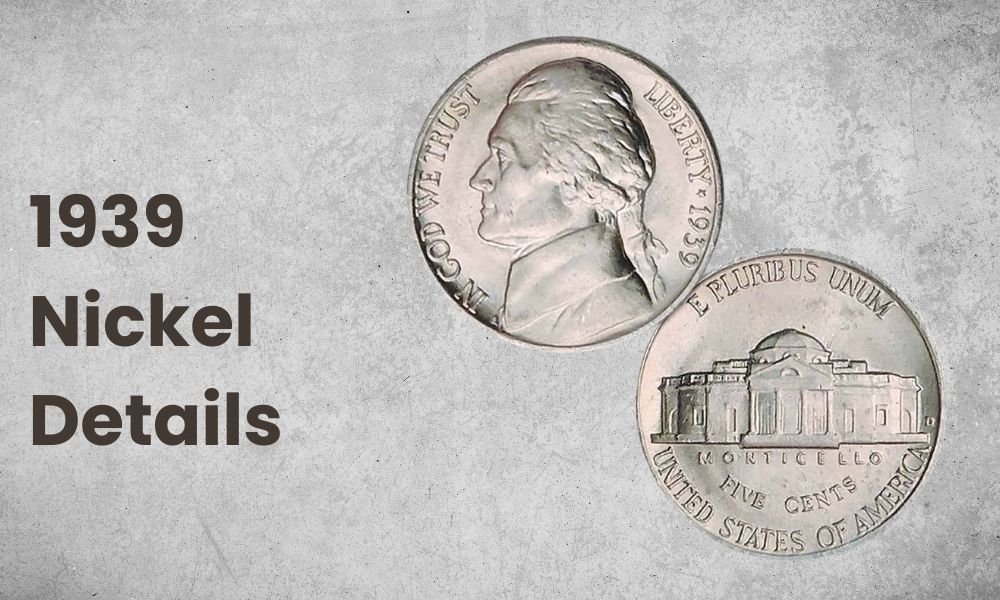
General details give you an idea of what the coin represents and what to look out for in each one. They may also give you a better idea of the value, especially when you consider the mintage.
- Category: Jefferson Nickels
- Mint: San Francisco, Denver, and Philadelphia
- Mintage: 130,771,535
- Obverse designer: Felix Schlag
- Reverse designer: Felix Schlag
- Composition: 75% copper, 25% nickel
- Edge: Plain
- Weight: 5.000 grams
- Diameter: 21.21 mm
Three mint branches struck the 1939 nickel: San Francisco, Denver, and Philadelphia mints. Each branch struck a different number of coins for that year, with Philadelphia striking the highest number, more than 90% of the entire mintage.
The Denver mint struck the lowest number, lower than the San Francisco mint, which is not a common occurrence. But the Denver mintage significantly affected its value; the coins with the D mint mark appear to be the most valuable on the list.
Nickels from the Philadelphia mint typically have no mint mark. If your 1939 nickel does not feature a mint mark on the reverse, it is from the Philly mint. However, if you find an S or D mint mark on the right side of the Monticello, it is from the San Francisco or Denver mint respectively.
There are no other markers distinguishing the coins from each other except for the mint marks. That is unless you have proof nickels. These are nickels with exceptional clarity and detail, with mirror-like shine or luster.
They are made on special planchets with dies burnished to produce excellent and unique results. There are 1939 Proof nickels, but only a little over 12,000 of them were struck for that year. This makes the quite valuable if you find any surviving ones.
Also Read: 15 Most Valuable Nickels Worth Money
1939 Nickel Value Chart
Here, we tabulate the value of the nickel, based on its mint mark and condition. These are two key factors that can make or mar the value of any coin.
| Mint Mark | Good | Fine | Extremely Fine | Uncirculated |
| 1939 No Mint Mark Nickel Value | $0.05 | $0.05 | $0.25 | $2.43 |
| 1939 ‘S’ Nickel Value | $0.67 | $0.96 | $2.24 | $18 |
| 1939 ‘D’ Nickel Value | $2.75 | $3.75 | $6 | $26 |
Since the Philly mint, which struck the no mint-mark coins, struck the highest number of coins, it is not strange to see that the coins from that main branch are the least valuable on the list. That does not mean they have no value; it depends on the condition and who is buying.
However, there are many still available today, and because they are abundant, they are not unique to collectors. Consequently, they are not very much sought-after. The San Francisco coins are a little different in value. They cost a little more than the Philly coins to buy or sell.
Collectors typically prefer coins with mint marks to those without any. Also, the San Francisco mint struck considerably fewer coins than the Philly coins, which makes the coins less abundant in circulation. Because of this, they are in demand and will fetch more than the no-mint-mark coins.
Finally, the Denver coins are the most valuable because of the mintage. They have the least struck number on the list, just a little over 3.5 million. Nevertheless, the mintage is not the only factor that makes the coins pricey. The coin details can change the value based on sharp relief or clarity.
Coin Grade
One of the first things any collector checks is the condition of the coin. As with other goods or merchandise, a buyer must evaluate the condition of the goods they are buying before paying for them. The same applies to the 1939 nickel and its value.
A coin can be in good condition, which means it has a lot of wear. Coins that have long been in circulation usually show a high level of wear. The details are no longer there, although the images’ silhouettes are still visible. In this condition, a coin does not attract much value.
The same is almost true of coins in fine condition, although they are typically better-looking than the former coins. But they also are not as attractive as coins in extremely fine or uncirculated conditions. Nevertheless, they are still valuable enough to cost about $3 for a 1939 nickel, depending on the mint mark.
The two best conditions are extremely fine and uncirculated or mint state + conditions. They still have the details in sharp relief and the luster is obvious. This is especially true for uncirculated coins. They typically cost more buyers and have the best value for sellers.
Also Read: Top 110 Most Valuable Nickels Worth Money
1939 Nickel Varieties and Value Guides
Let’s explore the coins in detail, separating them by their mint mark.
1939 No Mint Mark Nickel Value
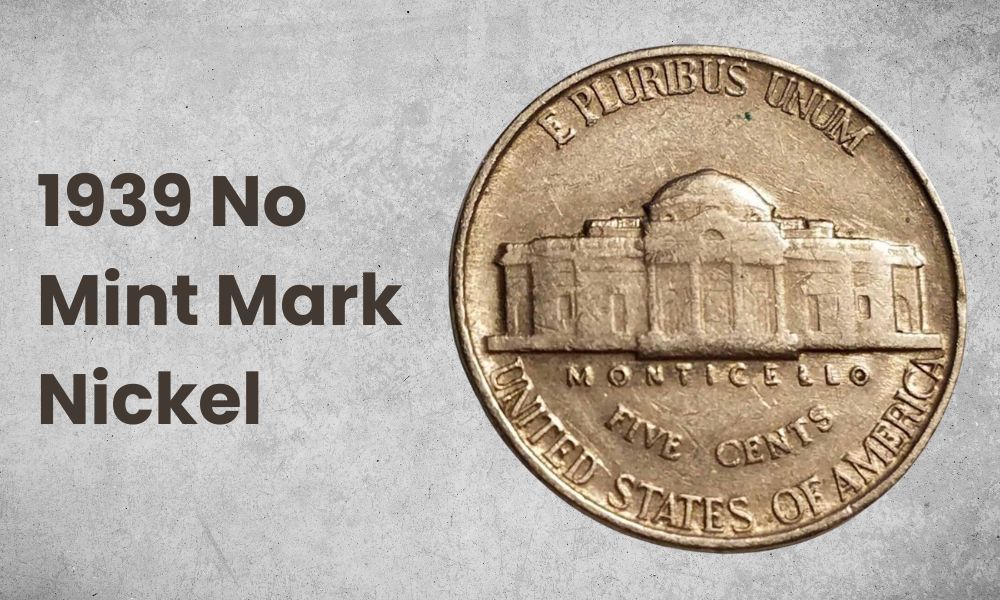
- Type: Jefferson Nickels
- Edge: Plain
- Mint mark: None
- Minting Location: Philadelphia
- Year of minting: 1939
- Face value: Five cents
- $ Price: $0.05 to $2 (or more)
- Quantity produced: 120,615,000
- Designer: Felix Schlag
- % Composition: 75% copper and 25% nickel
- Mass: 5.000 grams
- Diameter: 21.21 mm
The Philadelphia mint struck the 1939 no-mint-mark nickels, accounting for more than 90% of the entire mintage for that year. Because there are many of them, the value is very low. Sometimes, their value is as low as their face value.
These coins are the ones typically in circulation, so you will find them in mostly worn condition. But it does not always mean the value is low; some of the no-mint-mark coins may have a value in the high hundreds of dollars. It depends on who is buying it and the coin’s condition.
1939 ‘S’ Nickel Value
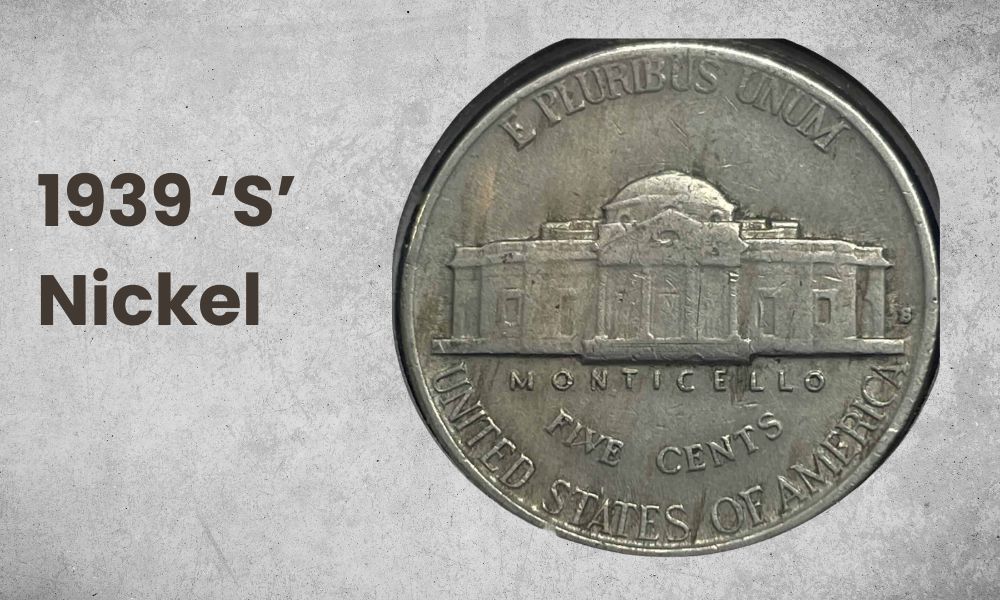
- Type: Jefferson Nickels
- Edge: Plain
- Mint mark: S
- Minting Location: San Francisco
- Year of minting: 1939
- Face value: Five cents
- $ Price: $0.67 to $18 (or more)
- Quantity produced: 6,630,000
- Designer: Felix Schlag
- % Composition: 75% copper and 25% nickel
- Mass: 5.000 grams
- Diameter: 21.21 mm
The San Francisco mint struck only a fraction of the entire mintage for that year, low enough to raise the demand for 1939-S nickels today. There are not many of them available and because of that, collectors are willing to pay a little more for them when available.
The S coin is the same as the Philly and Denver coins, with only the mint mark to differentiate them. But some of these coins may be valued at a much higher price, sometimes as much as $700.
1939 ‘D’ Nickel Value
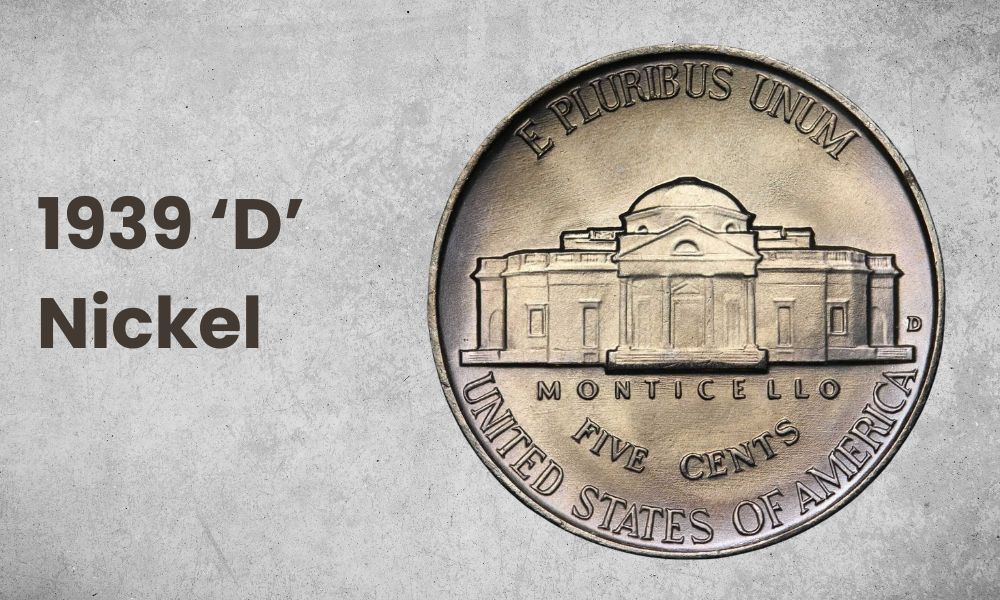
- Type: Jefferson Nickels
- Edge: Plain
- Mint mark: D
- Minting Location: Denver
- Year of minting: 1939
- Face value: Five cents
- $ Price: $2 to $26 (or more)
- Quantity produced: 3,514,000
- Designer: Felix Schlag
- % Composition: 75% copper and 25% nickel
- Mass: 5.000 grams
- Diameter: 21.21 mm (0.75 inches)
This coin is the most valuable in the 1939 series of Jefferson nickels. But while it looks and feels like the other coins, it has the D mint mark on the reverse, on the right of the Monticello. It also has the lowest mintage of all the coins struck that year.
Low mintage does not always mean that a particular coin will be very valuable. In this case, the Denver coins are not highly valuable, although the difference in price with the other coins is obvious. Still, the coin is much sought-after by collectors because of its rarity, especially in mint condition.
If the coin is in good or circulated condition, it may fetch as little as $5. In mint state, it may cost as much as $26, but it all depends on the details and the collector. For example, in 2019, a 1939-D coin in the mint state was sold for about $26,000.
1939 Nickel History
The former nickel, which was the Buffalo nickel, began its journey in 1913 and was not well-liked. The primary reason was because of the difficulty to strike the design on the coin planchet. The result was that the coin was not very clear and did not appear in sharp relief.
The effort to make the design appear better and sharper only damaged more dies than the Mint was ready to make a budget for, which was to the Treasury’s dislike. So, it was with gladness that the Mint and Treasury, under whose control the Mint was, to see the end of the Buffalo nickel after waiting for it to run its 25-year course.
By 1938, plans went into action to design and strike a nickel with a new design. The Mint held a competition where artists were invited to create the best design with the image of one of the founding fathers and the third president of the United States on the obverse, with an image of his house Monticello on the reverse.
The competition started in January of 1938 with a deadline of April 15 of the same year. At first, the entries came in trickles and while it seemed as if there was no interest, the entries began to increase toward the deadline.
About nine days after the deadline, the design by Felix Oscar Shlag was picked from over three hundred entries. However, there was a call for some changes on the reverse; the Monticello was only three-quarters visible and there was a palm tree by one side.
Officials did not like the visible tree, so Schlag had to redesign the reverse to remove the tree and create a plain view of the Monticello. This design was better accepted and the nickel went into production shortly after that.
The obverse bears a simple image of the third president of the country. The image is large and faces left, with the words IN GOD WE TRUST running in front of it. Behind his ponytailed head is the word LIBERTY with the mint year 1939 next to it.
The reverse bears the image of the president’s house standing stately and alone. The word MONTICELLO is written under the image and FIVE CENTS are right under it. Around the top are the words E PLURIBUS UNUM and around the bottom, near the rim, are the words UNITED STATES OF AMERICA. The mint mark is usually on the right side of the Monticello.
1939 Nickel Grading
The grading of a coin can range from 1 to 70 based on its condition. The better a coin looks and feels, the higher it goes on the grading scale; 70 is the best grade, although there is hardly any coin from any era left with that grade. The more worn it looks, the lower down the scale it goes.
This video explains the coins, what makes them valuable, and the grading of different 1939 nickels.
List of 1939 Nickel Errors
Only one error applies to the 1939 nickels. The other uniqueness lies in a variation in the design, which is not visible on many other coins. Let’s start with the known error before discussing the variation.
1. 1939 Nickel Doubled Monticello Error
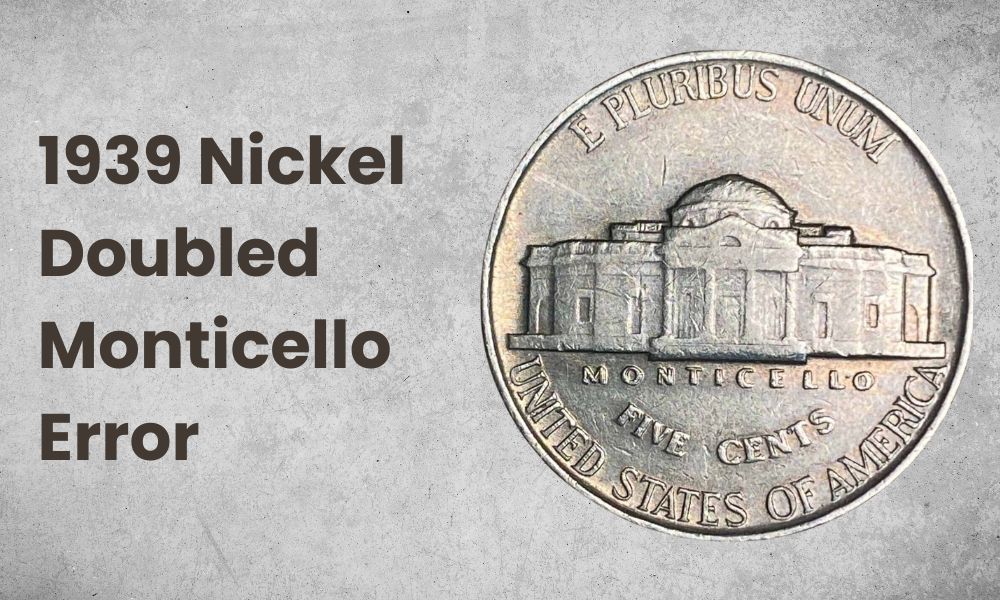
Some of the 1939 no-mint-mark coins have a doubled die error on the reverse. The error is on the dome of the Monticello and the denomination. This error refers to striking the coin to create a visible doubling on the site of the image.
In good grades, a DDO coin should fetch you about $125, but in mint state, it can go as high as $3,000. However, only a few of these coins exist, so it is difficult to find them. The best grades can sell for about $7,000.
2. 1939 Full Steps Variation
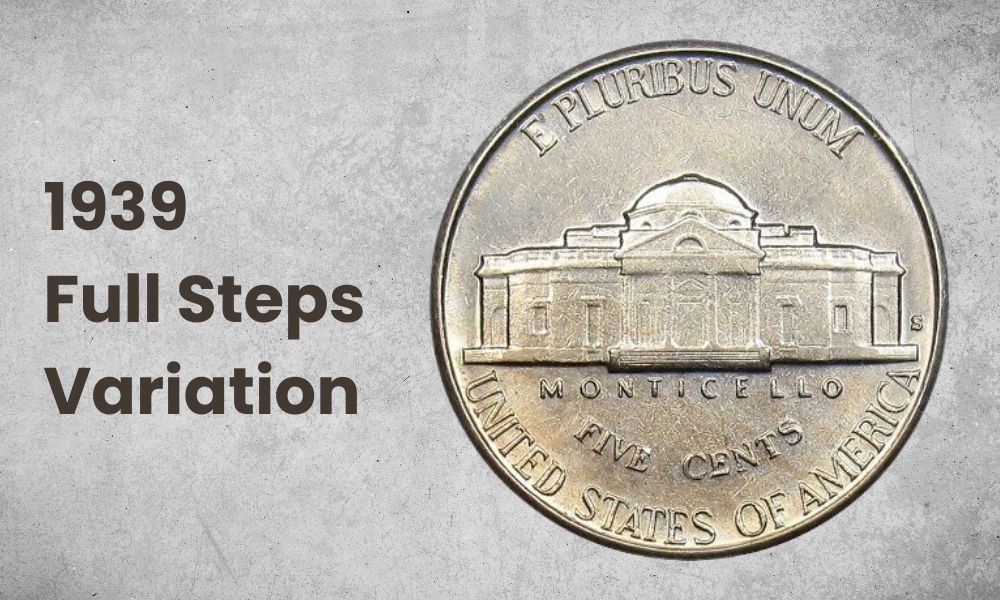
The full steps refer to the steps in front of the Monticello on the coin’s reverse. For the most part, the steps are one of the first details to wear off. It is pretty difficult to find a coin with visible steps.
This detail was not popular until the 1970s, and the sudden interest also increased the value of coins with clear steps. If your 1939 nickel has a visible image of four or five steps, the coin may be as valuable as $5,000. Some collectors may pay as much as $22,000 for a 1939-D nickel in MS+ condition.
1939 Nickel FAQs
Do 1939 nickels have silver in them?
1939 nickels do not have silver in them. Their metal composition is 25% nickel and 75% copper. Nickels within this series with silver in them run from 1942 to 1945, just after the war. You can identify such coins by checking for a bold S on top of the Monticello dome on the coin’s reverse.
How much is a 1939 D nickel worth?
The actual worth of a 1939-D nickel depends on the buyer and the condition of the coin. Typically, it is worth about $40 in its best state. But it is worth about $1,500 on the open market, with this value increasing based on the grade and special markers.
Also Read: Top 19 Most Valuable Jefferson Nickels Worth Money
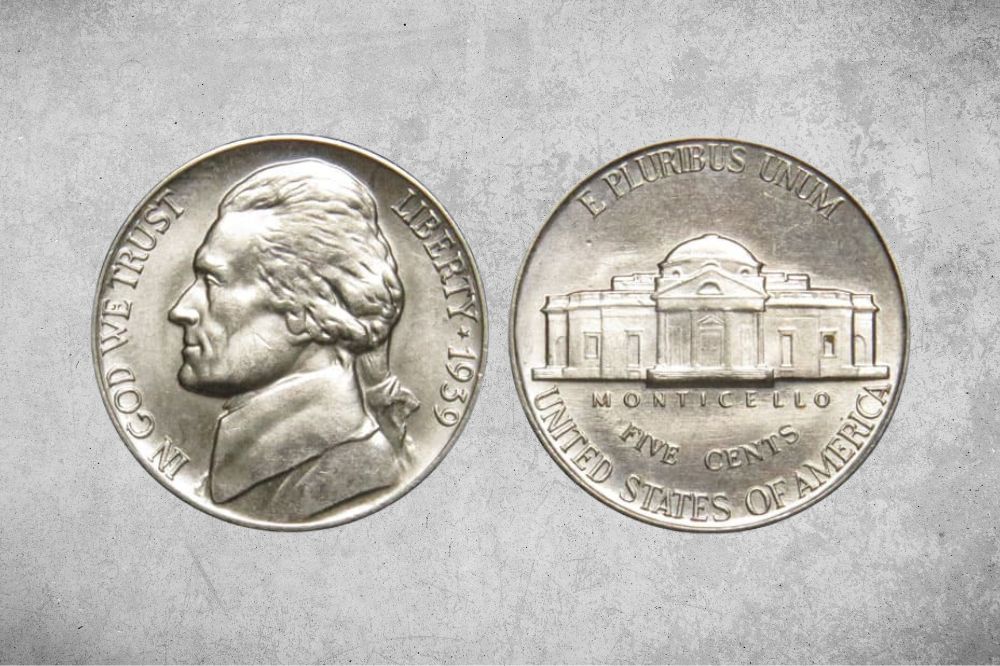
I have a 1939 no mint nickel that is missing the letter c in monticello. It appears that a dash mark is in its place. Wondering if this is rare and what the coin is worth.